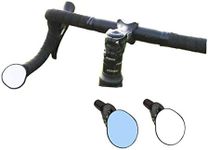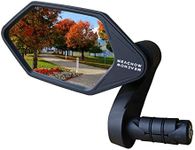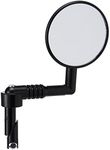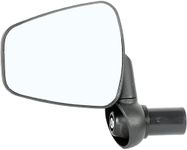Buying Guide for the Best Bike Mirrors
Choosing the right bike mirror can make your rides safer and more comfortable by improving your awareness of what's happening behind you. The best mirror for you depends on your riding style, the type of bike you have, and your personal preferences. It's important to consider how and where you'll be riding, as well as how much visibility and adjustability you need. Understanding the key features of bike mirrors will help you make a choice that fits your needs and enhances your cycling experience.Mounting LocationThe mounting location refers to where the mirror attaches to your bike, such as the handlebars, bar ends, or helmet. This is important because it affects your field of view, ease of installation, and how much the mirror might interfere with your riding. Handlebar-mounted mirrors are common and provide a stable view, while helmet-mounted mirrors move with your head and can offer a wider perspective. Bar-end mirrors are more discreet but may be less adjustable. To choose the right mounting location, think about your comfort, the type of bike you ride, and whether you want the mirror to be fixed or to move with your head.
Mirror SizeMirror size determines how much of the road behind you can be seen at a glance. Larger mirrors give a broader view, making it easier to spot vehicles or other cyclists, but they can be bulkier and more prone to vibration. Smaller mirrors are less obtrusive and lighter, but may require more precise positioning and can show less of what's behind you. If you ride in busy areas or at higher speeds, a larger mirror might be better, while casual riders or those concerned about aesthetics might prefer a smaller one.
AdjustabilityAdjustability refers to how easily you can change the angle or position of the mirror. This is important for getting the best possible view and for making quick adjustments while riding. Some mirrors have ball joints or flexible arms, allowing for a wide range of movement, while others are fixed in place. If you share your bike or often change your riding position, a highly adjustable mirror is useful. If you always ride in the same position, a fixed mirror might be sufficient.
Mirror MaterialThe material of the mirror affects its clarity, weight, and durability. Glass mirrors provide a clear, undistorted view but can be heavier and more fragile. Plastic mirrors are lighter and less likely to shatter, but may scratch more easily and sometimes offer less clarity. If you prioritize a clear view and don't mind a bit of extra weight, glass is a good choice. For rougher rides or if you want something lightweight and durable, plastic might be better.
Vibration ResistanceVibration resistance is about how well the mirror stays steady and clear while you ride, especially on rough roads. A mirror that vibrates too much can make it hard to see what's behind you. Some mirrors have special mounts or materials to reduce vibration. If you often ride on bumpy surfaces or at high speeds, look for a mirror known for good vibration resistance. For smoother city rides, this may be less of a concern.
Visibility and CoverageVisibility and coverage refer to how much of the road or path behind you the mirror lets you see. Some mirrors are convex, which means they curve outward and show a wider area, though objects may appear smaller. Flat mirrors show things at their true size but cover a narrower area. If you want to see as much as possible, especially in traffic, a convex mirror is helpful. If you prefer a more accurate sense of distance, a flat mirror might be better.
![Diyife Bike Mirror, [A Pair] Alumin](https://images-proxy.bestreviews.guide/V8set6VSsxiYaSpGGOqKKpV1CE0=/0x150/https://m.media-amazon.com/images/I/414oL0Js63L._AC_CX679_.jpg)













